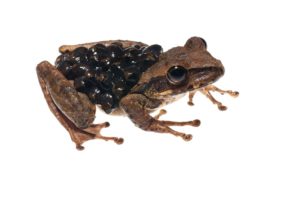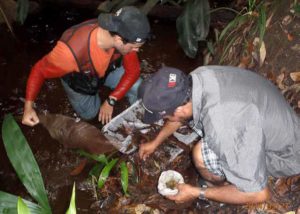Dozens of species, which are likely new to science, have been discovered in the Kaieteur National Park (KNP) and Upper Potaro area in Guyana during a month-long expedition by a team of intrepid researchers.
Some of these species found are thought to only occur in the Guiana Shield. These findings were among the most significant highlighted in a recent report released by World Wildlife Fund Guianas and Global Wildlife Conservation. The report is the second in a series which aims to highlight Guyana’s incredibly rich biodiversity and represents the most recent broad-based floral and faunal assessment in this unique region.
The publication reveals that:
1. More than 30 species, including 6 species of fish, 3 plants, 15 aquatic beetles and 5 odonates [an order of predatory insects that comprises the dragonflies] are more than likely new to science. Many species were also recorded for the first time in Guyana.
2. The Kaieteur Plateau – Upper Potaro provides important habitat for many charismatic and threatened species such as the Tepui Swifts, Jaguar, Guianan Cock of the Rock, White-lipped Peccary and an icon of the KNP, the Golden Rocket Frog.
3. More than 50% of birds, 40% of odonates, 30% of mammals, and 43% of amphibians known to occur in Guyana, inhabit the area.
The distinctiveness of the area’s biodiversity stems from several factors including the integrity of the undisturbed forest, river and stream habitats; its topography and geology and the isolating effect on species which the Kaieteur Falls and the presence of numerous rapids in the Potaro River exert. At the same time, however, human-induced pressure on the landscape is growing and was evident during the survey. For instance, aquatic beetles and odonates, whose presence are an indication of good water quality, were completely absent in some creeks where mining had taken place. Loss of forest and water quality due to mining not only has an impact on the environment and biodiversity but also on local people who rely on the area for their livelihoods, freshwater, fish, game, timber and other natural resources.

With such tremendous importance for nature and livelihoods, it is thus extremely important that economic development for the area and its inhabitants is based on the principle of using natural resources in a well-planned and sustainable way. In fact, maintaining the large-scale integrity of the landscape, which takes into account both highland and supporting the development of sustainable livelihoods is essential for the region’s long-term conservation.
The research teams hope that their results will be utilised to the fullest to guide land-use planning at the national level, managers of protected areas, particularly of the Kaieteur National Park, and community members and researchers to better understand the biodiversity of this area and to plan for its management.
The BAT survey was done in close partnership with the village of Chenapau; University of Guyana’s Departments of Biology and Agriculture, and Faculty of Earth and Environmental Sciences; and Protected Areas Commission. The launch took place at the Cara Lodge in Georgetown on November 16, 2017 with senior members of Government, including ministers; members of the diplomatic community; prominent environmentalists and other stakeholders, including the media, in attendance.

The full report can be accessed from www.wwfguianas.org (Text provided by the WWF Guianas) (Guyana Times Sunday Magazine)



